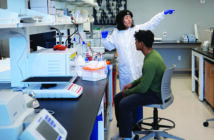Study discovers potential target for treating aggressive cancer cells.
Polyploidal giant cancer cells present several challenges for researchers: they’re aggressive, they’re resistant to treatment, and they’re hard to study because they don’t undergo mitosis, which is typically required for cell division. Instead, PGCCs divide via amitotic budding—and their cell structure enables them to spread rapidly.
Last fall researchers at Brown reported new discoveries about this process, as well as a potential treatment target.
According to the study, in Proceedings of the National Academy of Sciences, PGCCs rely on cell filaments called vimentin in order to migrate. Vimentin is found in cells throughout the body, but PGCCs were found to have more vimentin compared to non-PGCC control cells, and their vimentin as much more evenly distributed throughout the cell.
“These cells appear to play an active role in invasion and metastasis, so targeting their migratory persistence could limit their effects on cancer progression,” says senior author Michelle Dawson, PhD, an assistant professor of molecular pharmacology, physiology, and biotechnology.
She and her colleagues hope to next find a biomarker for PGCCs so that they can study these cells in human tumors. “This study shows vimentin is overexpressed in PGCCs and is likely responsible for several of their abnormal behaviors,” Dawson says. “Vimentin is a ubiquitous protein, so targeting vimentin directly may not be an answer, but drugs that target vimentin interactions may be effective in limiting the effects
of these cells.”



